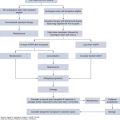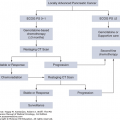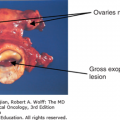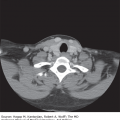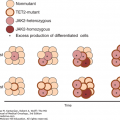VENOUS THROMBOEMBOLISM
Pulmonary embolism (PE) and deep venous thrombosis (DVT) are manifestations of venous thromboembolism (VTE). Approximately 20% of all VTEs are associated with cancer, and cancer increases the risk for VTE four- to sixfold. Surgery, chemotherapy, hormonal therapy, growth factors, angiogenesis inhibitors, immunomodulators, erythropoietic agents, and central venous catheters (CVCs) contribute to cancer-associated VTE (1). Risk of VTE is associated with the type of cancer and its clinical stage, with glioblastoma, stomach cancer, pancreatic cancer, lung cancer, gynecologic cancer, and leukemia frequently associated with VTE, and early-stage breast cancer, prostate cancer, and melanoma least commonly associated with VTE (1). Cancer-associated VTE is rarely lethal within 6 months of diagnosis and treatment (2), but it is often undiagnosed, and its onset can be associated with considerable mortality. Venous thromboembolism was the death certificate–attributed cause of death for 0.21% of patients with cancer in a large population-based death certificate review (3), the cause of 3.5% of 141 deaths recorded among 4,466 community hospital–treated ambulatory patients with cancer (4), and the objectively documented cause of death among 1.5% of all patients with cancer managed by a single cancer center (5).
Clinical presentations of VTE are not specific. Most patients with DVT have unilateral leg swelling and tenderness, and most patients with PE have abrupt-onset dyspnea and pleuritic chest pain. These symptoms are nonspecific, especially in patients who have cancer. Scoring systems developed to estimate pretest probability of DVT and PE (like the Well’s scores) can be used to rule out VTE in patients with cancer, but the likelihood of finding a normal D-dimer level among patients with cancer is less than 30%, and elevated D-dimers are of no positive predictive value (6). Doppler/compression ultrasound is the preferred method to diagnose DVT, although magnetic resonance imaging (MRI) and computed tomography (CT) may be required in special circumstances, such as internal iliac vein or vena cava thrombosis. High-resolution CT or CT angiography is the best method for diagnosing PE (7), and it offers the advantage of providing additional information regarding synchronous thoracic pathology that may confound the diagnosis of PE. Conversely, up to 5% of all chest CTs done for cancer staging, monitoring, and surveillance show asymptomatic incidental PEs (8).
Pharmacological VTE prophylaxis should be considered in every hospitalized patient with cancer for whom there is no contraindication (8). Contraindications to pharmacological anticoagulation are absolute (recent central nervous system bleed, intracranial or spinal lesion at high risk for bleeding, or major active bleeding: more than 2 units transfused in 24 hours) or relative (chronic, clinically significant measurable bleeding >48 hours; platelets <50,000/μL; platelet dysfunction [uremia, medications, dysplastic hematopoiesis]; recent major operation at high risk for bleeding; underlying hemorrhagic coagulopathy; high risk for falls; neuraxial anesthesia/lumbar puncture). Enoxaparin 40 mg, dalteparin 5,000 IU, or fondaparinux 2.5 mg subcutaneously once per day can be used for VTE prevention in patients with cancer.
Patients with cancer undergoing abdominal or pelvic surgery should receive low molecular weight heparin (LMWH) prophylaxis extended for 4 weeks (9). Routine pharmacological prophylaxis in ambulatory patients with cancer receiving chemotherapy is recommended only for patients with myeloma receiving thalidomide or lenalidomide as part of combination chemotherapy, although outpatient pharmacological prophylaxis can be considered in high-risk patients receiving systemic chemotherapy, such as those with pancreatic or gastric cancers (10).
Routine VTE induction therapy is used to treat symptomatic VTE or incidental PE. Incidental PEs, including those found in the subsegmental branches of the pulmonary artery, appear to have a recurrence risk similar to symptomatic PE and should be managed similarly. Preference is for LMWH—for example, enoxaparin 1 mg/kg/12 hours or dalteparin 200 IU/kg/24 hours—but infused unfractionated heparin should be used for patients with renal failure or nonsevere hemorrhage. Thrombolysis can be considered in cases of massive PE (defined as associated with systolic blood pressure <90 mm Hg lasting for more than 15 minutes), and an inferior vena cava (IVC) filter should be placed when anticoagulation is contraindicated. If the contraindication is temporary, a retrievable IVC filter is preferred.
Maintenance therapy is different from that for patients without cancer, however, as it is with LMWH because LMWH is better than warfarin at preventing recurrences (2). When tolerated, maintenance therapy should be continued indefinitely for most patients with active cancer (8,11). The risk of recurrent cancer-associated DVT after stopping anticoagulation can be stratified by examining residual venous thrombosis 6 months into treatment: Only 3/105 patients without residual venous thrombosis had recurrent DVT after stopping LMWH anticoagulation. The recurrence rate among those with residual venous thrombosis was high (49/242), and continuing anticoagulation for 6 months did not significantly affect the risk of recurrence (12).
The reason why LMWH is better than warfarin for maintaining anticoagulation (and may be better than the new oral anticoagulants [NOACs]) in patients with cancer is not clear. Preclinical data indicate that LMWH, but not warfarin or fondaparinux, inhibits tumor procoagulant activity by blocking mucin binding to endothelial, leukocyte, and platelet selectins. The LMWH also stimulates endothelial cell release of the potent natural anticoagulant protein tissue factor pathway inhibitor and binds to soluble inflammatory cytokines, thereby preventing their effect of shifting the endothelium toward an inflamed prothrombotic phenotype (13).
Recurrence of VTE on anticoagulation therapy is common in patients with cancer. The Comparison of Low-Molecular-Weight Heparin versus Oral Anticoagulant Therapy for the Prevention of Recurrent Venous Thromboembolism in Patients with Cancer (CLOT) trial from 2003 showed a best-case scenario of 9% recurrence at 6 months among those treated with LMWH maintenance (2). The more recent CATCH trial showed that we have not made great progress in the intervening decade: The recurrence rate was 6.9% at 6 months among patients receiving LMWH maintenance (14).
Optimal management of VTE recurrence remains uncertain. If the anti-FXa level drawn 4 hours after injection is not in the therapeutic range, the dose of LMWH should be adjusted, aiming toward the therapeutic peak anti-FXa level. If the anti-FXa level is therapeutic, one can increase the dose of LMWH by 20%, change to another anticoagulant, or place an IVC filter (11).
Mild thrombocytopenia (platelets <50,000/μL) is presented as a relative contraindication for anticoagulation by the American Society of Clinical Oncology and the National Comprehensive Cancer Network despite the lack of data about the risk of anticoagulation in patients with thrombocytopenia. There are, however, fairly consistent data that thrombocytopenia preventing pharmacological prophylaxis is a critical factor in the large risk of VTE and its recurrence among patients with acute leukemia (15) and following stem cell transplant (SCT) (16).
To address this conundrum, the Subcommittee on Haemostasis and Malignancy for the Scientific and Standardization Committee of the International Society of Thrombosis and Haemostasis has developed consensus guidelines (11). One recommendation is that patients with chronic thrombocytopenia be given dose-adjusted LMWH, with full-dose LMWH when the platelet count is greater than 50,000/μL; half-dose LMWH when the platelet count is between 25,000 and 50,000/μL; and no anticoagulation when the platelet count is less than 25,000/μL. Such an approach can also be considered for patients with cyclical thrombocytopenia from chemotherapy.
Catheter thrombosis may affect almost 50% of patients who have CVCs, although fewer than 5% of catheters are associated with symptomatic occlusive DVTs (17). In addition to all the other risk factors for DVT development in patients with cancer, the catheter type (peripherally inserted central catheter > centrally inserted catheters > implanted ports) and location (femoral > jugular > subclavian) affect the risk of developing a catheter-related DVT.
There is no evidence that anticoagulation prevents catheter-associated thrombosis, and all guidelines currently recommend against it. The diagnosis and treatment of catheter-associated DVT are, however, similar to the diagnosis and treatment of lower-extremity DVTs, with two special considerations. The first is that the catheter can be maintained in place during anticoagulation if it is functional and useful. In this case, therapeutic anticoagulation should be maintained for as long as the catheter is in place. The second is how to manage anticoagulation when a catheter has been removed because it is infected or no longer needed. Clinical guidelines recommend 3 months of anticoagulation after catheter removal.
Bleeding while on anticoagulation is common. During the first 6 months of treatment, about 3% of all patients with cancer will have major bleeding (generally defined as a fall in hemoglobin of 2 g over 24 hours, the need for 2 units of packed red blood cell transfusion over 24 hours, or bleeding into a vital organ or eye), and another 10% will have nonmajor bleeding (14). These rates may double during the next 6 months of anticoagulation. After the first year, they appear to stabilize (18).
Bleeding often develops unexpectedly at the beginning of treatment when LMWH unmasks a previously unrecognized bleeding threat (8). When major bleeding occurs, it is essential to stop anticoagulation, reverse it when appropriate (Table 56-1), and place an IVC filter.
| LMWH | Reversal Agent | Dosage | Comments |
|---|---|---|---|
| Enoxaparin (Lovenoxa) ½ life: 4.5-7 h | Protamine % Xa activity neutralized: Enoxaparin 54.2% Dalteparin 74% | Administer 1 mg of protamine for each 1 mg of enoxaparin or 100 IU of dalteparin IV slowly over 10 min or as a continuous infusion over 30 min. Rate should not exceed 5 mg/min. If enoxaparin/dalteparin was used greater than 8 h ago, then reduce dose by half (0.5 mg/1 mg enoxaparin)(0.5 mg/100 units of dalteparin). A second dose (0.5 mg/1 mg enoxaparin)(0.5 mg/100 IU dalteparin) of protamine may be given 2-4 h after the completion of the first dose. Single dose of protamine should not exceed 50 mg. Half-life is 10 min so repeat dosing may be needed. | Hypersensitivity reactions may occur in patients with known hypersensitivity to fish Monitoring: aPTT and anti-Xa Possible side effects of protamine: severe hypotension, anaphylaxis, dyspnea, bradycardia, flushing, a feeling of warmth especially when given too rapidly |
| Dalteparin (Fragmin®) ½ life: 4-8 h | Recombinant factor VIIa (Novo-Seven®): ½ life: 2.6-3.1 h | For life-threatening bleed that persists despite protamine administration: 20-30 μg/kg IV times 1 dose Repeat in 2 hours if needed Round to the nearest 1 mg | Monitoring: monitor for evidence of hemostasis A “normal” INR may not mean successful reversal Accepted by most Jehovah’s Witness patients |
The use of the DOACs—rivaroxaban, apixaban, and dabigatran—for cancer-associated VTE is generally discouraged, as few patients with cancer were included in the major trials of these agents, and there are no established procedures for monitoring or reversing their effects (19). Clinical trials are ongoing to determine the therapeutic index of these agents when they are used to prevent or treat cancer-associated VTE.
THROMBOTIC MICROANGIOPATHIES
Cancer-associated thrombotic microangiopathies (TMAs) are a group of disorders identified mainly by descriptive clinical characteristics, always involving the presence of circulating schistocytes associated with intravascular hemolysis (elevated lactate dehydrogenase LDH and indirect bilirubin), anemia, and when the bone marrow is healthy, elevated reticulocytes. Anemia and thrombocytopenia are the principle clinical manifestations, but there may also be end-organ dysfunction from microvascular thrombosis, particularly in the kidneys. Cancer-associated TMAs are distinguished from disseminated intravascular coagulation (DIC) by normal coagulation studies and D-dimer levels.
Stay updated, free articles. Join our Telegram channel

Full access? Get Clinical Tree



